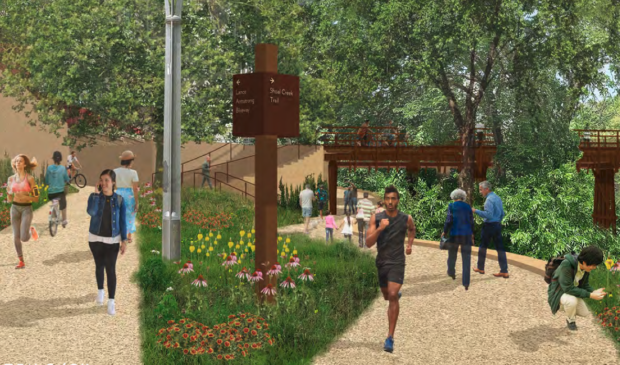Shoal Creek/Third Street redesign aims to create greener, safer spaces downtown
Tuesday, September 14, 2021 by
Kali Bramble The Urban Transportation Commission’s hefty meeting agenda on Sept. 7 included a proposal to significantly redesign the heavily trafficked area of downtown surrounding the intersection of Third Street and Shoal Creek Trail.
The Cypress and Shoal Creek Public Space Strategy, a joint effort between the Downtown Austin Alliance, Shoal Creek Conservancy and the city of Austin, seeks to resolve the chaotic convergence of pedestrian, cyclist and vehicular traffic. The project consists of several new concepts for plazas, underpasses, bikeways and other connecting features designed to connect the popular downtown area to the surrounding urban trail network.
“The project is in an area of downtown where we have devoted a lot of public dollars to creating important community resources that are meant to serve a citywide audience … (such as) the new Central Library, the Seaholm Development District and Butler Hike and Bike Trail,” said Nina Rinaldi, who was presenting on behalf of the Shoal Creek Conservancy. The project was developed with the idea that these investments are essential resources that should be easily accessible to all ages, ability levels and modes of transport.
The new design would involve closing Power Plant Drive to vehicle traffic and creating a series of pedestrian-only plazas along Third Street that would eventually extend past Shoal Creek Trail to the rest of downtown. These plazas would serve to alleviate safety hazards caused by overlapping car, foot and bike traffic; better connect the disjointed Seaholm development; and “activate public space” for the surrounding community.
The plan also calls for renovating outdated structures like the railroad trestle at Third Street and Shoal Creek, which has been abandoned since the 1990s. This concept involves widening the pedestrian bridge over the creek and transforming the trestle into a pedestrian-only walkway that would relieve traffic congestion and allow for a more comfortable coexistence between walkers and cyclists.
Along with plazas and bridges, the project outlines new Shoal Creek trail connections at its intersections with Third Street and Rio Grande. These new access points are designed to make this section of the hike-and-bike trail easily navigable by visitors of all ages and ability levels, as well as provide opportunities for streambank restoration.
While most of its designs have been developed to accommodate growing needs over the past few years, the Cypress and Shoal Creek project also includes plans for a Bowie Street underpass, which has been repeatedly proposed and derailed since the creation of the Seaholm Master Plan in 2001.
The underpass, which would connect walkers and bikers from the Pfluger pedestrian bridge to West Third Street, has been plagued by its intersection with the Union Pacific Railroad and its $8.6 million price tag. The most recent negotiations with Union Pacific came to an abrupt halt this summer, when Austin’s Economic Development Department conceded that the railroad giant’s inflexible terms had rendered the project unfeasible.
Given this development, Rinaldi admitted the team may have to consider “alternative strategies” to complete their vision of connecting these disparate parts of downtown. Still, they are optimistic about the proposal’s other goals. With each of the seven projects’ price tags ranging from $3.5 million to $9 million, the estimated cost of the completed design adds up to the substantial sum of $43 million, an amount that’s within the total funds available in the Seaholm Tax Increment Finance District, which exists in part to finance improvements to the area’s public spaces.
While the proposal was warmly received by the commission, it will ultimately take an amendment to the Seaholm TIF plan via City Council vote to receive the necessary funding and move forward.
This story has been changed since publication to reflect the fact that Nina Rinaldi was speaking on behalf of the Shoal Creek Conservancy. Rendering courtesy of Shoal Creek Conservancy and Ten Eyck Landscape Architects.
The Austin Monitor’s work is made possible by donations from the community. Though our reporting covers donors from time to time, we are careful to keep business and editorial efforts separate while maintaining transparency. A complete list of donors is available here, and our code of ethics is explained here.
You're a community leader
And we’re honored you look to us for serious, in-depth news. You know a strong community needs local and dedicated watchdog reporting. We’re here for you and that won’t change. Now will you take the powerful next step and support our nonprofit news organization?







